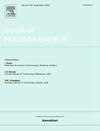二维/一维和三维SN节点耦合中子输运计算方法
IF 2.3
3区 工程技术
Q1 NUCLEAR SCIENCE & TECHNOLOGY
引用次数: 0
摘要
二维/一维中子输运方法是高保真中子输运计算的常用方法。对于一些研究或试验反应堆,反应堆堆芯被重水包围,重水外面是轻水。为了得到核外重水域和轻水域的谱,必须将重水域和轻水域计算在内。当使用2D/1D方法时,这将显著影响计算时间和收敛性。为此,提出了一种基于二维/一维方法和三维SN节点方法的中子输运方法。该方法将堆芯划分为两个计算域。反应堆活动堆芯采用二维/一维精细网格法计算,反应堆堆芯外区域采用三维SN节点法计算。两个计算域通过边界角通量耦合。为了加快计算速度,还采用了CMFD和并行方案。该方法应用于C5G7基准和JRR-3堆芯。数值试验表明,在保持精度的前提下,该方法的效率和收敛性都明显优于二维/一维耦合方法。本文章由计算机程序翻译,如有差异,请以英文原文为准。
A neutron transport calculation approach via the coupling of 2D/1D and 3D SN nodal methods
The 2D/1D neutron transport method is a popular approach for high-fidelity neutron transport calculations. For some research or testing reactors, the reactor core is surrounded by heavy water, and outside the heavy water is light water. To obtain the spectrum in the heavy water and light water outside the core, the heavy water and light water domains must be included in the calculation. This significantly affects the calculation time and convergence when using the 2D/1D method. Therefore, a new neutron transport method based on the 2D/1D method and the 3D SN nodal method is proposed to address these issues. In this method, the reactor core is divided into two calculation domains. The reactor active core is calculated by the 2D/1D method with fine meshes, while the region outside the reactor core is calculated by the 3D SN nodal method. The two calculation domains are coupled by the boundary angular flux. The CMFD and parallel scheme are also implemented to accelerate the calculations. This method is applied to the C5G7 benchmark and JRR-3 reactor core. The numerical tests show that the efficiency and convergence of the coupling method are much better than those of the 2D/1D method while maintaining accuracy.
求助全文
通过发布文献求助,成功后即可免费获取论文全文。
去求助
来源期刊

Annals of Nuclear Energy
工程技术-核科学技术
CiteScore
4.30
自引率
21.10%
发文量
632
审稿时长
7.3 months
期刊介绍:
Annals of Nuclear Energy provides an international medium for the communication of original research, ideas and developments in all areas of the field of nuclear energy science and technology. Its scope embraces nuclear fuel reserves, fuel cycles and cost, materials, processing, system and component technology (fission only), design and optimization, direct conversion of nuclear energy sources, environmental control, reactor physics, heat transfer and fluid dynamics, structural analysis, fuel management, future developments, nuclear fuel and safety, nuclear aerosol, neutron physics, computer technology (both software and hardware), risk assessment, radioactive waste disposal and reactor thermal hydraulics. Papers submitted to Annals need to demonstrate a clear link to nuclear power generation/nuclear engineering. Papers which deal with pure nuclear physics, pure health physics, imaging, or attenuation and shielding properties of concretes and various geological materials are not within the scope of the journal. Also, papers that deal with policy or economics are not within the scope of the journal.
 求助内容:
求助内容: 应助结果提醒方式:
应助结果提醒方式:


